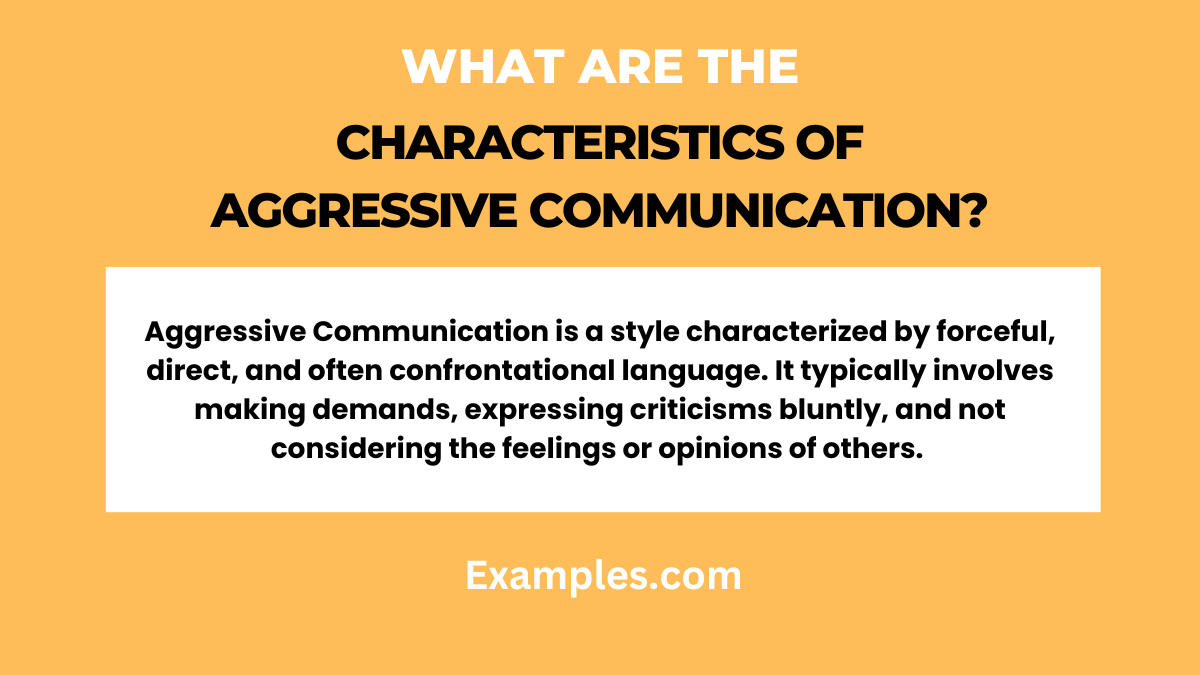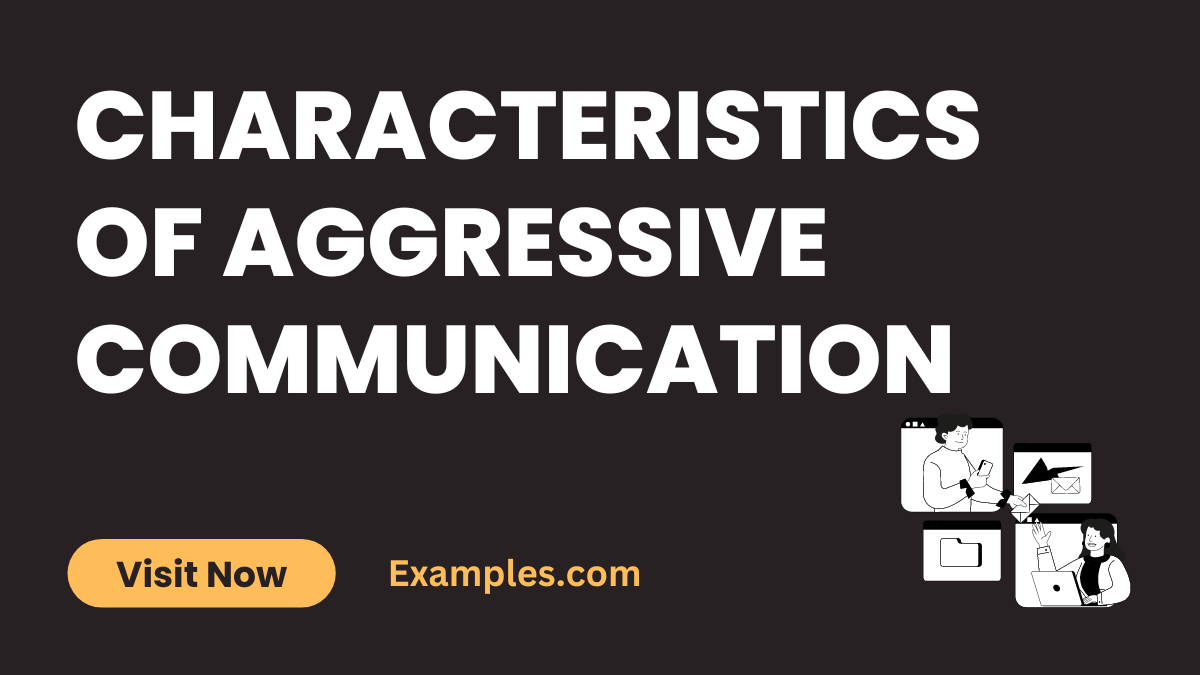Characteristics of Aggressive Communication
Discover the intricacies of Aggressive Communication through our detailed guide, enriched with Aggressive Communication Examples. This guide delves deep into the core characteristics of aggressive interactions, illustrating them with practical examples. Ideal for anyone looking to understand the nuances of this communication style, our guide provides insights on how to identify and adapt to aggressive communication in various settings. Enhance your communication skills and learn to navigate complex interactions with confidence and clarity.
What are the Characteristics of Aggressive Communication?

Aggressive Communication is a style characterized by forceful, direct, and often confrontational language. It typically involves making demands, expressing criticisms bluntly, and not considering the feelings or opinions of others. This communication style can lead to misunderstandings, conflicts, and damaged relationships, both in personal and professional settings. Unlike Assertive Communication, which respects both parties’ views, aggressive communication often crosses the line into disrespect and can include verbal attacks and intimidation. Understanding these characteristics is vital for identifying and effectively responding to aggressive interactions.
What are the 10 Characteristics of Aggressive Communication
Aggressive communication, often misunderstood and misapplied, is a critical concept to grasp in various interpersonal dynamics. This communication style is characterized by ten distinct features, each contributing to its overall impact. These characteristics include direct confrontation, intimidation tactics, manipulation, verbal attacks, impatience and interruption, sarcasm and mockery, blame and accusation, overbearing behavior, hostile body language, and a dismissive attitude. Understanding these aspects is crucial for recognizing and effectively managing aggressive communication in personal and professional settings.
1. Direct Confrontation in Aggressive Communication

Direct Confrontation is a prevalent trait in Aggressive Communication. It involves blatantly expressing opinions, often at the expense of others’ feelings, leading to escalated conflicts and damaged interpersonal dynamics. This approach starkly contrasts with more empathetic communication styles.
2. Intimidation Tactics in Aggressive Communication

Intimidation Tactics in aggressive communication rely on instilling fear to influence and control others. This can create an oppressive atmosphere, adversely affecting team dynamics and personal relationships, and is particularly detrimental in Aggressive Communication in the Workplace.
3. Manipulation in Aggressive Communication

Manipulation in aggressive communication involves using deceptive techniques to exert control. This aspect erodes trust and transparency, crucial in healthy personal and professional interactions, and is often identified as a negative trait in Aggressive Communication Styles.
4. Verbal Attacks in Aggressive Communication

Verbal Attacks are common in aggressive communication, characterized by harsh criticisms and personal insults. This not only harms relationships but also hinders the possibility of constructive feedback and resolution, a significant issue in Aggressive Communication Methods.
5. Impatience and Interruption in Aggressive Communication

Impatience and Interruption signify a lack of respect and attentiveness in aggressive communication. This behavior leads to one-sided interactions, where the aggressive party dominates, impeding effective Communication in Relationships.
6. Sarcasm and Mockery in Aggressive Communication

Sarcasm and Mockery, used in aggressive communication, aim to demean or belittle others. This approach creates a hostile environment and can damage both personal and professional relationships, contrary to the principles of Non Aggressive Communication.
7. Blame and Accusation in Aggressive Communication

Frequent Blame and Accusation are indicative of aggressive communication, often deflecting responsibility. This trait fosters a defensive environment, obstructing collaborative problem-solving and is counterproductive in scenarios like Aggressive Communication in Nursing.
8. Overbearing Behavior in Aggressive Communication

Overbearing Behavior in aggressive communication is about dominating conversations and decisions. This can stifle creativity and independence, impacting team morale and individual confidence, especially in settings like Aggressive Communication in the Workplace.
9. Hostile Body Language in Aggressive Communication

Hostile Body Language accompanies verbal aggression, with gestures and expressions that can intimidate or threaten. This nonverbal aspect reinforces aggressive communication, making interactions more confrontational and less conducive to constructive dialogue.
10. Dismissive Attitude in Aggressive Communication

A Dismissive Attitude in aggressive communication reflects a disregard for others’ opinions or feelings. This approach leads to communication breakdowns and fails to recognize or value others’ contributions, an issue prevalent in Aggressive Communication in Relationships.
Aggressive Communication Style Characteristics
Aggressive Communication Style is often marked by a distinctive set of characteristics that can significantly impact both the sender and the receiver in any interaction. Understanding these traits is vital for identifying Aggressive Communication in various environments, from personal relationships to professional settings.
One of the primary characteristics of this style is a tendency to dominate conversations. Individuals exhibiting aggressive communication often assert their opinions forcefully, leaving little room for others to express their views. This can lead to a one-sided dialogue where the aggressive communicator’s needs and opinions overshadow those of others.
Another notable aspect is the use of direct and often blunt language. While directness can be beneficial, in aggressive communication, it often crosses the line into disrespect. Such communication may involve harsh criticisms, personal attacks, and derogatory remarks, which can be damaging to the recipient’s self-esteem and confidence.
Hostility is also a common trait in aggressive communication. This can manifest through not just words, but also through nonverbal cues like aggressive body language – for example, pointing fingers, invading personal space, or using intimidating facial expressions. Hostile communication can create an environment of fear or discomfort, hindering open and honest dialogue.
Aggressive communicators also tend to employ tactics like interruption and impatience during conversations. They may frequently cut others off or display visible frustration when conversations do not align with their expectations or pace. This behavior can make the interaction unpleasant and unproductive.
Additionally, aggressive communication often involves placing blame and making accusations. Instead of focusing on problem-solving or understanding the other person’s perspective, the aggressive communicator might pinpoint faults and assign blame, further escalating conflicts.
Understanding these Characteristics of Aggressive Communication is crucial for those who wish to communicate more effectively and adapt their style to be more inclusive and respectful. Recognizing these traits can also help individuals respond appropriately when faced with aggressive communication, enabling them to maintain professionalism and composure in various situations.
In conclusion, this guide on the Characteristics of Aggressive Communication provides essential insights for recognizing and addressing this communication style. Understanding these traits is key to fostering more respectful and productive interactions. Whether in personal relationships or professional environments, adapting our communication strategies and responding appropriately to aggression can significantly enhance the effectiveness and quality of our interactions.



